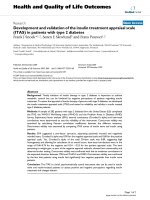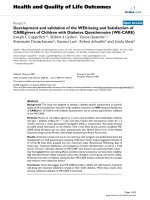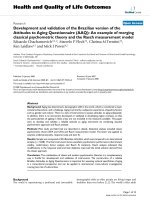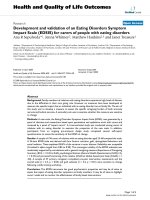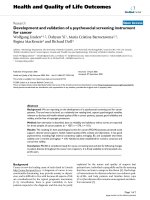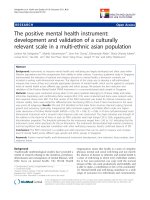Development and validation of a Chinese parental health literacy questionnaire for caregivers of children 0 to 3 years old
Bạn đang xem bản rút gọn của tài liệu. Xem và tải ngay bản đầy đủ của tài liệu tại đây (997.33 KB, 9 trang )
Zhang et al. BMC Pediatrics
(2019) 19:293
/>
RESEARCH ARTICLE
Open Access
Development and validation of a Chinese
parental health literacy questionnaire for
caregivers of children 0 to 3 years old
Yan Zhang1,2,3, Mu Li4, Hong Jiang1,2*, Huijing Shi1,2, Biao Xu5, Salla Atkins6,7 and Xu Qian1,2
Abstract
Background: Given the limited information on parental health literacy measurements, the study aimed to develop
and validate the Chinese Parental Health Literacy Questionnaire for caregivers of children 0 to 3 years old.
Methods: We conducted a validity and reliability study of the questionnaire through a cross-sectional survey and
test-retest analysis respectively between March and April 2017. We recruited 807 caregivers of children 0 to 3 years
old, among them 101 caregivers completed the test-retest assessment with 2 weeks interval. The reliability was
determined by internal consistency, spilt-half reliability and test-retest reliability. The construct validity was assessed
by confirmatory factor analysis.
Results: The 39-question Chinese Parental Health Literacy Questionnaire was demonstrated high internal consistency
(Cronbach’s α = 0.89), spilt-half reliability (Spearman-Brown coefficient = 0.92) and test-retest reliability (Pearson correlation
coefficient = 0.82). The confirmatory factor analysis showed that the construct of the questionnaire fitted well with the
hypothetical model. The participants’ test scores of the Chinese Parental Health Literacy Questionnaire in the crosssectional survey were positively associated with caregivers being mothers, more educated, the children with Shanghai
Hukou, having only one child in the family, and higher family income.
Conclusion: The Chinese Parental Health Literacy Questionnaire demonstrated good reliability and validity, which could
potentially be used as an effective evaluation instrument to assess parental health literacy.
Keywords: Young children, Parental health literacy, Anticipatory guidance, Scale development
Background
Improving child health is core to the Sustainable Development Goals [1]. In the past decades, the survival rate
of children under 5 years old has improved significantly
globally. In low- and middle-income countries, however,
250 million children under 5 years old are at risk of not
achieving their developmental potential [2]. Early child
development largely depends on the quality of nurturing
and care provided to the children in the family. Studies
have showed that inappropriate caring practice was
adversely associated with child development and health [3].
* Correspondence:
1
Department of Maternal, Child and Adolescent Health, School of Public
Health; Global Health Institute, Fudan University, Mailbox 175, No. 138 Yi Xue
Yuan Road, Shanghai 200032, People’s Republic of China
2
Key Lab of Health Technology Assessment, National Health Commission of
the People’s Republic of China, Fudan University, Shanghai, China
Full list of author information is available at the end of the article
Health literacy is a better predictor of health condition
than income, employment, education, race or ethnicity
[4]. In China, the 2016 health literacy surveillance reported that only 11.58% Chinese residents had basic
health literacy [5]. Caregivers with lower health literacy
had difficulty in comprehending important aspects of
pediatric anticipatory guidance, including coping with
common family emergencies, weighing risks and benefits
of routine vaccinations, and conducting home safety
checks [6]. Children whose parents had low health literacy often had poor health outcomes, such as poor
asthma control and poor glycemic control, especially for
younger children [7, 8]. Low health literacy in parents
was also associated with a variety of adverse health behaviors, including not practicing breastfeeding [9], poor
performance of administering medicine prescribed [10],
which could have adverse effects on children’s health.
© The Author(s). 2019 Open Access This article is distributed under the terms of the Creative Commons Attribution 4.0
International License ( which permits unrestricted use, distribution, and
reproduction in any medium, provided you give appropriate credit to the original author(s) and the source, provide a link to
the Creative Commons license, and indicate if changes were made. The Creative Commons Public Domain Dedication waiver
( applies to the data made available in this article, unless otherwise stated.
Zhang et al. BMC Pediatrics
(2019) 19:293
Currently, there are several scales to assess adult health
literacy, such as Test of Functional Health Literacy in
Adults (TOFHLA) [8], Rapid Estimate of Adult Literacy in
Medicine (REALM) [11] and Newest Vital Sign (NVS)
[12]. However, other than the Parental Health Literacy
Activities Test (PHLAT) [6], no instrument has been specifically developed for evaluating parental health literacy
of caregivers of young children. The PHLAT was designed
for parents of children younger than 13 months, and
mainly assessing parents’ literacy and numeracy skills in
understanding instructions of caring for children [6].
In 2012, the World Health Organization Regional
Office for Europe developed a broader and inclusive
definition of health literacy, “people’s knowledge, motivation and competences to access, understand, appraise,
and apply health information in order to make judgments and take decisions in everyday life concerning
health care, disease prevention and health promotion to
Page 2 of 9
maintain or improve quality of life during the life
course” [4, 13]. This suggests that the measurement of
health literacy should be multi-dimensional.
Given the limited information on parental health
literacy measurements, our study aimed to develop a
Chinese Parental Health Literacy Questionnaire (CPHLQ)
for caregivers of children 0 to 3 years old.
Methods
Instrument development
The development of the Chinese Parental Health Literacy
Questionnaire comprised two stages as illustrated in
Fig. 1.
Stage 1: conceptual framework and indicators generation
The CPHLQ was based on the conceptual framework
developed by Sorenson et al. in 2012, operationalized
with a 3 × 4 matrix, including three health domains
Fig. 1 Diagram for the procedures followed to develop the Chinese Parental Health Literacy Questionnaire
Zhang et al. BMC Pediatrics
(2019) 19:293
(health care, disease prevention, and health promotion)
and four factors of information processing (accessing,
understanding, appraising, and applying) for each domain [13].
Indicators were generated through three steps. Firstly,
10 key topics about children’s physical development in
three health domains were extracted from literature review and confirmed by a 20-expert consultation (Table 1).
The 20 experts were selected purposively. They are experts in child health care or health education, including
researchers, pediatricians and child health care doctors.
Pneumonia and diarrhea, the two leading infectious causes
of childhood morbidity and mortality, were suggested to
represent childhood common diseases in the health care
domain. Secondly, several indicators were developed based
on the 10 key topics and the four factors of information
processing. Thirdly, 14 of the 20 experts completed a tworound Delphi consultation for confirming content representativeness, health literacy relevance, feasibility and significance of these indicators. At the results of these three
steps, 34 parental health literacy indicators were identified
by consensus [14].
Stage 2: questionnaire development
Questions were designed based on the 34 indicators.
Among them, 29 indicators were directly transformed
into 29 questions; for the remaining five indicators, one
indicator was converted into two to four questions. As
the result, a 41-question CPHLQ were constructed. Each
question, reflecting the factors of information processing
of “accessing”, “appraising”, or “applying”, was rated with
a 4-point Likert scale [15]. Meanwhile, questions relevant to information processing of “understanding” were
mainly in the form of true/false questions or multiple
choices with four options, designed to test the knowledge level among caregivers. For true/false questions,
the correct answer would score 4 points. For multiple
choice questions there were 4 options in a question,
each option was a true/false question, and one correct
choice would score 1 point. Each question also had an
option of “Don’t know” which would get a ‘zero’ score.
Therefore, each question had a score ranging from 0 to
4. Examples of the questions in the CPHLQ are showed
in Table 2.
Table 1 Key topics about children’s physical development in
three health domains
Domain
Key topics
Health care
Pneumonia and diarrhea; antibiotic use; health
examination
Disease
prevention
Vaccination; obesity and malnutrition; vitamin D and
iron deficiency; oral and visual health care
Health
promotion
Infant and child feeding; unintentional injury
prevention; scientific parental care
Page 3 of 9
The original version of the 41-question CPHLQ was
reviewed by one researcher, two child care doctors and
two nurses to assess whether the questions were consistent to the indicators. The doctors and nurses came from
the department of child health care of a Community
Health Center (CHC) in Shanghai, whose main duties
were providing medical consultation and health education for caregivers of children. The original version of
the questionnaire was piloted with 10 parents to identify
any ambiguous or unclear questions and to revise the
wording. Minor changes were made to enhance clarity
and comprehension.
Validation of CPHLQ
Participants and data collection
The study used a methodological design with a convenience sampling scheme. Usually for a validation study,
the recommended sample size for each question is between 2 and 20 subjects; and the total sample of 500
participants is considered as good, 1000 or more as excellent [16]. Eight of the sixteen districts in Shanghai
were willing to participate in the study, including three
urban districts, three suburban districts and two outer
suburban districts. Considering the sample size recommendations and the feasibility, minimum 100 participants from each district (at least 800 participants in
total) were required. The target participants were the
primary caregivers (including parents, grandparents and
other caregivers, like nanny) of children under 3 years
old. In Shanghai, the routine child health care is provided by CHCs. Therefore, in each participating district,
three CHCs were selected as the study sites, representing
high, medium and low social economic status (based on
local economic indicators and child health care management rates). A cross-sectional survey was conducted in
24 CHCs from eight districts in Shanghai. Before the
survey, two child health care doctors in each selected
CHC were invited as co-investigators and were trained
about how to recruit participants and complete the selfadministered questionnaire.
Caregivers coming to these CHCs between March and
April 2017 and meeting the inclusion criteria were
invited to join in the survey by the trained doctors. The
inclusion criteria were as follows: a) above grade three
primary educations, b) able to communicate verbally or
literally with the investigators; c) willing to participate in
the study. In total 1090 caregivers were approached, and
807 (74.0%) caregivers completed the questionnaire. In
order to evaluate test-retest reliability, each study site
invited four or five participants to complete the questionnaire again 2 weeks later. Finally, 101 participants
completed the questionnaire for the retest. Responses in
the first survey by this sample of 101 participants were
also used for item analysis.
Zhang et al. BMC Pediatrics
(2019) 19:293
Page 4 of 9
Table 2 Examples of the Chinese Parental Health Literacy Questionnaire
Indicators
Questions
Accessing
Get information about children’s health checkup How easy is it for you to get information about your children’s health checkup?
①very difficult ②fairly difficult ③fairly easy ④easy ⑤don’t know
Understanding
Know about the common manifestations of iron (1) What are the common symptoms/signs when children have iron deficiency?
and vitamin D deficiency in children
①the child looks pale (especially lips, fingernail) ②loss of appetite ③upset ④fatigued ⑤don’t
know
(2) What are the common symptoms/signs when children have vitamin D deficiency?
①easy to wake up and sweaty at night ②pillow bald patch③muscle weakness ④in serious
cases, knock knees and bow legs ⑤don’t know
Understand the harm of dental caries in children “If tooth decay occurs in baby teeth, it does not require treatment, because tooth decay will go
away after replacing with the permanent teeth.” Is it true?
①true ②false ③don’t know
Appraising
Pay attention to children and find the early signs Can you recognize the signs of some common diseases (such as pneumonia, diarrhea) from
of some common diseases in time
your child’s physical conditions (such as alertness, body temperature, loose motions)?
①very difficult ②fairly difficult ③fairly easy ④easy ⑤don’t know
Applying
Ensure children vaccinated according to the
local immunization program
Can you always take your baby to scheduled vaccinations as doctor advised?
①always ②in most cases ③sometimes I fail ④rarely do⑤don’t know
Data on demographics were also collected from the
participants, including caregiver’s relationship with the
child, education level, family income, child’s age, gender,
and Hukou (the Chinese official residency registration by
location, which is directly linked to social costs, social
benefits and administration). During the survey, the primary spoken language of the study participants was
Mandarin, and the questionnaire was administered in
Chinese.
Item analysis
Based on Classical Test Theory, item analysis was conducted to screen each question’s performance and to ensure the appropriate questions were preserved [17]. The
question performance is determined by item difficulty
and item discrimination. Item difficulty is calculated as
the average score of a particular question divided by the
full score of the question, in our study the full score was
4; and for each question the higher this value is the
easier the question will be [18]. Item discrimination is
examined using the question-total correlation [19]. A
question should be deleted, when: a) item difficulty
lower than 0.2 or higher than 0.8 [20, 21]; and b) the coefficient of question-total correlation lower than 0.3 [19].
The results were shown in Additional file 1. Based on
the above described analysis, three questions were
identified to be deleted, “See the doctor in time when
suspecting the child has pneumonia”, “Recognize
possible risk factors of malnutrition in children”, and
“Ensure children fully vaccinated according to the local
immunization program”. However, considering the
importance of immunization for children, the third
question was remained and other two questions were
deleted. The 39-question questionnaire across 3 × 4 subdomains was finalized. The final CPHLQ was organized
into three subscales: 12-question for health care health
literacy (HC-HL), 16-question for disease prevention
health literacy (DP-HL), and 11-question from health
promotion health literacy (HP-HL).
Reliability and validity tests
Several psychometric properties of the 39-question
CPHLQ and the three subscales were assessed.
The internal consistency was measured with Cronbach’s α [22]. Spilt-half reliability was measured with
Spearman-Brown coefficient between odd questions and
even questions [22]. Test-retest reliability was measured
with the Pearson correlation coefficient between the
CPHLQ results completed by the 101 caregivers with a
two-week interval [22]. In addition, the reliability analysis of the three subscales was also performed. For the
whole scale, values greater than 0.70 indicated acceptable reliability [23, 24]. For each of the subscales, values
greater than 0.6 were considered as acceptable reliability
[25]. The floor or ceiling effects were assessed by the
proportion of respondents who received the lowest or
the highest score [26].
Given that hypothesized constructs were identified with a
priori model, confirmatory factor analysis (CFA) was used
to verify the construct validity [27]. The analysis was conducted separately for the three subscales for HC-HL, DPHL and HP-HL, in which questions were loaded into four
factors related to the four information-processing domains
of accessing, understanding, appraising and applying. The
Zhang et al. BMC Pediatrics
(2019) 19:293
Page 5 of 9
model fit was considered ‘relatively good’ if the following criteria were met: root mean square error of
approximation (RMSEA) lower than 0.08; goodness-offit index (GFI) greater than 0.90; adjusted goodness-offit index (AGFI) greater than 0.90; comparative fit index
(CFI) greater than 0.90; and due to the large sample,
χ2/df lower than 5 [28, 29]. The content validity was
confirmed by the expert panel.
literacy, disease prevention health literacy, health promotion health literacy), Cronbach’s α coefficient was
0.72, 0.86 and 0.61, respectively; Spearman-Brown
coefficient was 0.75, 0.90 and 0.68, respectively; and testretest reliability coefficient was 0.69, 0.82 and 0.68,
respectively.
Statistical analysis
The results showed a relatively good fit of all the fourfactor structure within the three domains of parental
health literacy (Table 4).
When calculating the scores for parental health literacy,
the weight of each indicator was based on the significance assessed during Delphi consultation, and was
equally allocated to the questions related to the indicator. The total score was transformed to percentage grading system, with the full score of 100. The scores of the
three subscales and the four competences were also calculated and standardized from 0 to 100. The mean and
standard deviation (SD) of CPHLQ scores were calculated. A higher score indicated that the caregiver had
higher health literacy. Additionally, descriptive statistics
of the participants’ characteristics were tabulated. The
relationships between scores and demographic characteristics were assessed with either a t-test or a one-way
ANOVA.
CFA was conducted with maximum likelihood estimation by using AMOS 21.0. Internal consistency, spilt-half
reliability, test-retest reliability and other parametric
tests were computed by using SPSS 20.0. The significance level was set at P < 0.05.
Results
Results of the validation study of the 39-question
CPHLQ using a cross-sectional survey are presented
below.
Social and demographic characteristics of participants
In total, 807 caregiver-child pairs participated in the
study. There were 551 mothers (68.3%), 178 fathers
(22.1%) and 78 grandparents or other caregivers (9.6%).
The social and demographic characteristics of the caregivers and their children are shown in Table 3. 64.9%
caregivers had college or above education. Among the
participants’ children, 52.0% were boys, 67.0% were
registered as Shanghai Hukou; and 70.5% were the onlychild. 70.5% participants reported to have a family
monthly income of over RMB 4500 (USD 678) (Table 3).
Reliability
The overall 39-question CPHLQ had high internal
consistency (Cronbach’s α = 0.89), high spilt-half reliability (Spearman-Brown coefficient = 0.92) and high test-retest reliability (Pearson correlation coefficient = 0.82).
Regarding the three subscales (health care health
Validity
Construct validity
Descriptive statistics for the CPHLQ
The mean CPHLQ score of this sample of caregivers of
children under 3 years old was 72.8 ± 12.5, ranged 6.0 to
96.8. No floor or ceiling effects was found. The standardized scores of the three subscales (health care,
disease prevention and health promotion) were 72.7 ±
11.5, 76.1 ± 16.7, 67.4 ± 14.6, respectively. Furthermore,
the standardized scores of the four competences (accessing, understanding, appraising and applying) were 68.7 ±
13.5, 77.0 ± 18.9, 72.6 ± 12.6, 74.3 ± 13.4, respectively.
As shown in Table 3, mothers had higher CPHLQ total
scores than fathers and grandparents or other caregivers
(P<.001). The higher CPHLQ total scores were associated
with higher education level (P<.001) and higher family
income (P<.001). In addition, higher CPHLQ total scores
were also associated with caregivers’ children had Shanghai
Hukou (P<.001) and were the only child (P = 0.004). Scores
of the CPHLQ were not significantly associated with child’s
age (P = 0.659) or gender (P = 0.384).
Discussion
The 39-question CPHLQ was developed for evaluating
parental health literacy among caregivers of children 0
to 3 years old in China. The validation study was carried
out among primary caregivers who lived in Shanghai.
The range of the CPHLQ score is between 0 and 100, a
higher score indicates higher parental health literacy
level. Psychometric analysis results indicated that the
CPHLQ has good reliability and validity, and it could
potentially be a useful instrument for assessing parental
health literacy for people who care for children aged
under 3 years in the Chinese context.
Nutbeam suggested that the measurement of health
literacy would be best achieved where content and context were well defined [30]. This study was based on the
conceptual framework of health literacy [13], which integrated the content of medical services and public health,
and emphasized the individual’s comprehensive literacy
abilities, including functional, interactive, and critical
health literacy. The application of this conceptual framework provides a better clarity for the connotation of
Zhang et al. BMC Pediatrics
(2019) 19:293
Page 6 of 9
Table 3 Social and demographic characteristics of participants and scores of CPHLQa
N = 807
CPHLQ score (total = 100)
n (%)
Mean (SD)
Mother
551 (68.3)
74.5 (10.98)
Father
178 (22.1)
69.2 (15.1)
Grandparents and others
78 (9.6)
68.5 (13.4)
F (P) or t (P)
Relationship to the child
27.901(<0.001)
Caregiver’s education
Junior school and below
126 (15.6)
64.8 (12.5)
High school
157 (19.5)
67.1 (12.8)
College
176 (21.8)
74.4 (11.6)
University or higher
348 (43.1)
77.4 (10.2)
522 (64.7)
72.5 (12.6)
155.903(<0.001)
Child’s age (years)
≤1
1~2
191 (23.7)
72.8 (12.4)
2~3
94 (11.6)
73.8 (12.2)
Female
387 (48.0)
73.2 (12.8)
Male
420 (52.0)
72.4 (12.2)
0.417 (0.659)
Child’s gender
0.870 (0.384)
Child’s Hukou
Shanghai
541 (67.0)
75.0 (11.7)
Other provinces
267 (33.0)
68.3 (12.5)
Yes
569 (70.5)
73.6 (11.8)
No
238 (29.5)
70.7 (13.8)
7.362(<0.001)
Only-child or not
2.882 (0.004)
Family monthly income per capita (in RMB)
a
<4500
179 (22.1)
69.7 (14.4)
4500~7500
220 (27.3)
73.1 (12.6)
7500~12,500
183 (22.7)
75.1 (10.1)
≥ 12,500
156 (19.3)
75.1 (10.8)
I don’t know
69 (8.6)
68.2 (13.9)
27.154(<0.001)
CPHLQ Chinese Parental Health Literacy Questionnaire
health literacy and provides a theoretical basis for the
development of instruments for assessing health literacy.
The interactive and critical health literacy involve more
advanced cognitive and social skills that can be applied
to participate, analyze and better control over life events;
while the functional health literacy refers to the basic
skills in reading and writing [13]. We found that caregivers scored lower in the competences of accessing,
appraising and applying (referring to the interactive and
critical health literacy) compared with the competence
Table 4 Construct Validity of CPHLQ with goodness-of-fit indices
Model a
Questions
Absolute model fit
Incremental fit
Parsimonious fit
RMSEA
GFI
AGFI
CFI
χ2/df
HC-HL
12
0.05
0.97
0.95
0.94
2.94
DP-HL
16
0.05
0.95
0.93
0.95
3.27
HP-HL
11
0.07
0.96
0.93
0.89
4.87
a
Four-factor model of each domain included accessing, understanding, appraising, and applying health information
HC-HL health care health literacy; DP-HL disease prevention health literacy; HP-HL health promotion health literacy; RMSEA root mean square error of
approximation; GFI goodness-of-fit index; AGFI adjusted goodness-of-fit index; CFI comparative fit index
Zhang et al. BMC Pediatrics
(2019) 19:293
of understanding (referring to the functional health literacy). This indicates that a comprehensive health literacy
intervention is needed to empower caregivers to access,
appraise and apply health information. A systematic
review showed that a mixed measurement approach can
broaden the health literacy concept and enable research
to address multiple skills [31]. In the CPHLQ, we used a
4-point Likert scale to determine the ability of “accessing”, “appraising”, and “applying” health information,
and used true/false questions or multiple choice to
assess the “understanding” of the health information
among caregivers.
The psychometric evaluation of the CPHLQ produced
plausible results. The overall 39-question questionnaire
was reliable, demonstrated by high internal consistency,
spilt-half reliability and test-retest reliability (the coefficients were all over 0.8). For the three subscales, all reliability coefficients were over 0.6 which was considered
as acceptable reliability for subscales [25]. The results of
confirmatory factor analysis showed that the construct
of the questionnaire fitted well with the theoretical
model. Despite the comparative fit index (CFI) was
below the recommended criteria of 0.90 in HP-HL, it
still represented a tolerable fit [32, 33]. In addition, we
used several methods to ensure the content validity of
the questionnaire. We applied the health literacy integration conceptual framework (2012) by Sorenson et al.
[13] to construct the CPHLQ. We ensured that the
CPHLQ covered the key content of the physical development of children 0 to 3 years old through literature
review and expert consultation. We also followed the
content development procedures strictly during the
questionnaire development process [34] which led to the
good content validity.
The study found that mothers’ parental health literacy
was significantly higher than fathers, grandparents and
other caregivers. This could be due to that in the Chinese
culture fathers are less involved in caring for children despite the vital role of fathers in child development [35]. The
finding highlighted that in practical terms fathers should
not be neglected when carrying out the health education
about caring children under 3 years old. In line with other
studies, our study found that lower health literacy was significantly associated with lower education level and lower
family income [36, 37]. We also found caregivers whose
children had Shanghai Hukou scored higher than those
whose children did not have Shanghai Hukou. This is
consistent with findings from another study that the level
of health literacy among Shanghai residents was higher
than the average of the country [38]. This might be
partially due to relatively higher education level of
Shanghai residents and health care resources, for example
health promotion and health information are more
accessible among Shanghai registered family [39]. Another
Page 7 of 9
interesting finding was that caregivers of two or more
children had lower parental health literacy than caregivers of only one child. This indicated that the caregivers of only one child might pay more attention to
parenting and child care.
The development and validation of an appropriate
instrument is an essential step for parental health
literacy research. To our knowledge, this is the first
study of developing and evaluating a parental health
literacy questionnaire for caregivers of children under
3 years old in China. Using the CPHLQ in a larger
and representative sample to determine cutoff point,
and in different settings in China are needed. The
instrument could potentially be used in other Chinese
population, and adapted for the use in other places of
the world. Furthermore, the CPHLQ can help to
identify the population in need of parenting and child
care related information. Therefore, it will be useful
for developing targeted interventions to improve the
parental health literacy of caregivers of children 0 to
3 years old and the quality of care.
There are several limitations of this study. Firstly, the
parenting health literacy presented in this manuscript
only involved the physical development and health of
children. Secondly, since the participants in this study
were all from Shanghai, one of the most developed areas
of China, further studies are needed to test the application of instrument in other regions and settings of
China. Thirdly, majority questions are based on selfreporting. There might be response bias, for example
some participants might overestimate their parenting
ability.
Conclusions
The Chinese Parental Health Literacy Questionnaire has
demonstrated good reliability and validity. It could potentially be used as an effective instrument for assessing
the Chinese parental health literacy of caregivers of
children 0 to 3 years old. The CPHLQ may also help to
develop targeted interventions to improve the parental
health literacy of caregivers of children under 3 years old
and their parenting behaviors.
Additional file
Additional file 1: Results of item analysis in the pretest and the final
version of Chinese Parental Health Literacy Questionnaire. (DOCX 19 kb)
Abbreviations
AGFI: Adjusted goodness-of-fit index; CFA: Confirmatory factor analysis;
CFI: Comparative fit index; CHC: Community health center; CPHLQ: Chinese
Parental Health Literacy Questionnaire; DP-HL: Disease prevention health
literacy; GFI: Goodness-of-fit index; HC-HL: Health care health literacy; HPHL: Health promotion health literacy; RMSEA: Root mean square error of
approximation
Zhang et al. BMC Pediatrics
(2019) 19:293
Acknowledgements
The authors were grateful to Shanghai Scientific Association of Better
Birth and Better Upbringing and Pudong, Huangpu, Changning, Jiading,
Songjiang, Baoshan, Fengxian, Jinshan District centers for Women and
Children’s Health of Shanghai, China for their support during data
collection. We also thank all the participants for their collaboration.
Page 8 of 9
7.
8.
9.
Authors’ contributions
YZ participated in study design, conducted data acquisition, analysis and
interpretation, drafted the initial manuscript, and reviewed and revised the
manuscript; HJ conceptualized and designed the study, draft and revised the
manuscript; ML, BX and SA critically reviewed the manuscript for important
intellectual content; HS and XQ conceptualized the study and reviewed and
revised the manuscript; and all authors approved the final manuscript as
submitted.
10.
11.
12.
Funding
The study was funded by grant GWIV-31 from Shanghai Municipal Health
Commission.
Availability of data and materials
The raw dataset analyzed in the current study are available from the
corresponding author on reasonable request.
Ethics approval and consent to participate
The study was approved by the Institutional Review Board of the School of
Public Health, Fudan University, Shanghai, China. All participants provided
the written informed consents.
Consent for publication
Not applicable.
13.
14.
15.
16.
17.
Competing interests
The authors declare that they have no conflict of interests.
18.
Author details
1
Department of Maternal, Child and Adolescent Health, School of Public
Health; Global Health Institute, Fudan University, Mailbox 175, No. 138 Yi Xue
Yuan Road, Shanghai 200032, People’s Republic of China. 2Key Lab of Health
Technology Assessment, National Health Commission of the People’s
Republic of China, Fudan University, Shanghai, China. 3Jiading District Center
for Disease Control and Prevention, Shanghai, China. 4School of Public
Health, University of Sydney, Sydney, Australia. 5Department of Epidemiology,
School of Public Health, Global Health Institute, Fudan University, Shanghai,
China. 6New Social Research and Faculty of Social Sciences, Tampere
University, Tampere, Finland. 7Karolinska Institute, Stockholm, Sweden.
19.
Received: 17 May 2019 Accepted: 14 August 2019
20.
21.
22.
23.
24.
25.
References
1. UN-DESA. Sustainable Development Goal 3 United Nations, Division for
Sustainable Development Goals. 2018. .
org/sdg3. Accessed 30 May 2018.
2. Britto PR, Lye SJ, Proulx K, Yousafzai AK, Matthews SG, Vaivada T, et al.
Nurturing care: promoting early childhood development. Lancet. 2017;
389(10064):91–102.
3. WHO. Early child development [in Chinese]. 2018. />maternal_child_adolescent/topics/child/development/zh/. Accessed 10 May
2018.
4. Kickbusch I. Health literacy: the solid facts. Geneva: WHO Regional Office for
Europe; 2013.
5. National Health Commission of the People’s Republic of China. The level of
health literacy of Chinese residents in 2016: Surveillance results. http://www.
nhc.gov.cn/xcs/s3582/201711/308468ad910a42e4bbe9583b48dd733a.shtml.
Accessed 1 June 2018.
6. Kumar D, Sanders L, Perrin EM, Lokker N, Patterson B, Gunn V, et al. Parental
understanding of infant health information: health literacy, numeracy, and
the parental health literacy activities test (PHLAT). Acad Pediatr. 2010;
10(5):309–16.
26.
27.
28.
29.
30.
31.
32.
33.
Nakamura D, Ogawa M, Nakamura T, Izawa KP. Impact of Parents'
Comprehensive health literacy on BMI in children: a multicenter crosssectional study in Japan. J Sch Health. 2018;88(12):910–6.
Harrington KF, Zhang B, Magruder T, Bailey WC, Gerald LB. The impact of
Parent's health literacy on pediatric asthma outcomes. Pediatr Allergy
Immunol Pulmonol. 2015;28(1):20–6.
Kilfoyle KA, Vitko M, O'conor R, Bailey SC. Health literacy and Women's
reproductive health: a systematic review. J Women's Health (Larchmt). 2016;
25(12):1237–55.
Yin HS, Dreyer BP, Foltin G, van Schaick L, Mendelsohn AL. Association of
low caregiver health literacy with reported use of nonstandardized dosing
instruments and lack of knowledge of weight-based dosing. Ambul Pediatr.
2007;7(4):292–8.
Sanders LM, Thompson VT, Wilkinson JD. Caregiver health literacy and the
use of child health services. Pediatrics. 2007;119(1):e86–92.
Liechty JM, Saltzman JA, Musaad SM. Health literacy and parent attitudes
about weight control for children. Appetite. 2015;91:200–8.
Sorensen K, Van den Broucke S, Fullam J, Doyle G, Pelikan J, Slonskaand Z,
et al. Health literacy and public health: a systematic review and integration
of definitions and models. BMC Public Health. 2012;12:80.
Zhang Y, Jiang H, Shi HJ. Application of Delphi method to establish
an evaluation system of health literacy of parents with children under
6 years old [in Chinese]. Matern Child Health Care Chin. 2017;32(23):
5809–12.
Sorensen K, Van den Broucke S, Pelikan JM, Fullam J, Doyle G, Slonska Z, et
al. Measuring health literacy in populations: illuminating the design and
development process of the European health literacy survey questionnaire
(HLS-EU-Q). BMC Public Health. 2013;13:948.
Anthoine E, Moret L, Regnault A, Sebille V, Hardouin JB. Sample size used to
validate a scale: a review of publications on newly-developed patient
reported outcomes measures. Health Qual Life Outcomes. 2014;12:176.
Nunnally J, Bernstein I. Psychometric theory. 3rd ed. New York:
McGraw-Hill; 1994.
Kline TJB. Classical test theory: Assumptions, equations, limitations, and item
analyses. In: Psychological testing: A practical approach to design and
evaluation. Thousand Oaks: SAGE Publications, Inc; 2005. p. 91–107.
Hawker GA, Davis AM, French MR, Cibere J, Jordan JM, March L, et al.
Development and preliminary psychometric testing of a new OA pain
measure--an OARSI/OMERACT initiative. Osteoarthr Cartil. 2008;16(4):409–14.
Lord FM. The relation of the reliability of multiple-choice tests to the
distribution of item difficulties. Psychometrika. 1952;17(2):181–94.
Attali Y, Saldivia L, Jackson C, Schuppan F, Wanamaker W. Estimating item
difficulty with comparative judgments. ETS Res Rep Ser. 2014;2014(2):1–8.
Zhang WT, Dong W. Advanced SPSS statistical analysis [in Chinese], vol. 451.
Beijing: Higher Education Press; 2013.
Sakane Y, Yamaguchi M, Yokoi N, Uchino M, Dogru M, Oishi T, et al.
Development and validation of the dry eye-related quality-of-life score
questionnaire. JAMA Ophthalmol. 2013;131(10):1331–8.
Cronbach LJ. Coefficient alpha and the internal structure of tests.
Psychometrika. 1951;16(3):297–3343.
George D, Mallery P. SPSS for windows step by step: a simple guide and
reference 11.0 update (4th ed.). Boston: Allyn & Bacon; 2003.
Chau PH, Leung AY, Li HL, Sea M, Chan R, Woo J. Development and
validation of Chinese health literacy scale for low salt consumption-Hong
Kong population (CHLSalt-HK). PLoS One. 2015;10(7):e0132303.
Osborne RH, Batterham RW, Elsworth GR, Hawkins M, Buchbinder R. The
grounded psychometric development and initial validation of the health
literacy questionnaire (HLQ). BMC Public Health. 2013;13:658.
Bentler PM, Bonett DG. Significance tests and goodness of fit in the analysis
of covariance structures. Psychol Bull. 1980;88(3):588–606.
Schumacker R, Lomax R. A beginner's guide to structural equation
modeling. 2nd ed. London: Lawrence Erlbaum Associates; 2004.
Nutbeam D. Defining and measuring health literacy: what can we learn
from literacy studies? Int J Public Health. 2009;54(5):303–5.
Altin SV, Finke I, Kautz-Freimuth S, Stock S. The evolution of health literacy
assessment tools: a systematic review. BMC Public Health. 2014;14:1207.
Kline RB. Principles and practices of structure equation modeling (3rd). New
York: The Guilford Press; 2011.
Duong TV, Aringazina A, Baisunova G. Nurjanah, Pham TV, Pham KM, et al.
Measuring health literacy in Asia: validation of the HLS-EU-Q47 survey tool
in six Asian countries. J Epidemiol. 2017;27(2):80–6.
Zhang et al. BMC Pediatrics
(2019) 19:293
34. Devellis WR. Scale Development: Theory and Applications [in Chinese].
Chongqing: Chongqing University Press; 2016. p. 218.
35. Friedman D, Masek B, Barreto E, Baer L, Lapey A, Budgeand E, et al. Fathers
and asthma care: paternal involvement, beliefs, and management skills. J
Pediatr Psychol. 2015;40(8):768–80.
36. van der Heide I, Rademakers J, Schipper M, Droomers M, Sorensen K, Uiters
E. Health literacy of Dutch adults: a cross sectional survey. BMC Public
Health. 2013;13:179.
37. Sorensen K, Pelikan JM, Rothlin F, Ganahl K, Slonska Z, Doyle G, et al. Health
literacy in Europe: comparative results of the European health literacy
survey (HLS-EU). Eur J Pub Health. 2015;25(6):1053–8.
38. Ya-fei H, Run-jie C, Xin-feng P, Shen-bing G, Yuan D. Study on healthy
literacy among 15-69-year-old residents of Shanghai City in 2012 [in
Chinese]. Chin J Health Educ. 2015;2(31):151–4.
39. Na J, Ji L, Guo-Wei Z, Ke-Li W, Hong-Bo C, Xu Q. Study on the current
situation of basic child healthcare service utilization in a central urban area
of Shanghai city [in chinses]. Matern Child Health Care Chin. 2013;35(28):
5757–60.
Publisher’s Note
Springer Nature remains neutral with regard to jurisdictional claims in
published maps and institutional affiliations.
Page 9 of 9



